Physical Address
304 North Cardinal St.
Dorchester Center, MA 02124
Physical Address
304 North Cardinal St.
Dorchester Center, MA 02124

Transform your living room into a serene, minimalist sanctuary. Discover 23 practical tips for decluttering, choosing furniture, and using light to inspire creativity.
Picture this: You’re standing in your living room, the space that’s supposed to be for relaxing, for connecting, for unwinding. But instead, your eyes are darting everywhere. There’s a stack of mail on the side table, three throw blankets slung over the sofa, a tangle of charging cords snaking from the wall, and shelves so full they look like they’re about to buckle. As an artist and a designer, I see this all the time. Your physical space is a direct reflection of your mental space. And a cluttered room is like creative static—it’s impossible to think clearly, let alone feel inspired.
The good news is, creating a serene, minimalist living room isn’t about getting rid of all your stuff and living in a sterile white box. That’s the biggest misconception out there. It’s about intention. It’s about curating a space where every single object has a purpose, a story, or brings you genuine joy. It’s about designing a canvas for your life, not a storage unit. I’m going to walk you through how to do this, not with a bunch of corporate jargon, but with the real, practical advice I share with my clients. This is the stuff that actually works.
Before you touch a single thing, we need to get your head in the right space. This whole process starts with a shift in how you think about your belongings and the room they live in. This isn’t just “cleaning up”—it’s fundamentally changing your relationship with your environment so that the calm you create actually lasts.
Before you even think about tossing a single magazine, you have to ask yourself the most important question: What is this room for? I don’t mean “for sitting.” I mean, what is the soul of this space? Is it a quiet sanctuary for reading and deep focus? A vibrant hub for family game nights? A calm backdrop for conversation with friends? Without this “Creative Brief” for your room, you’re just moving clutter around. Your ‘why’ becomes the filter for every single decision you make.
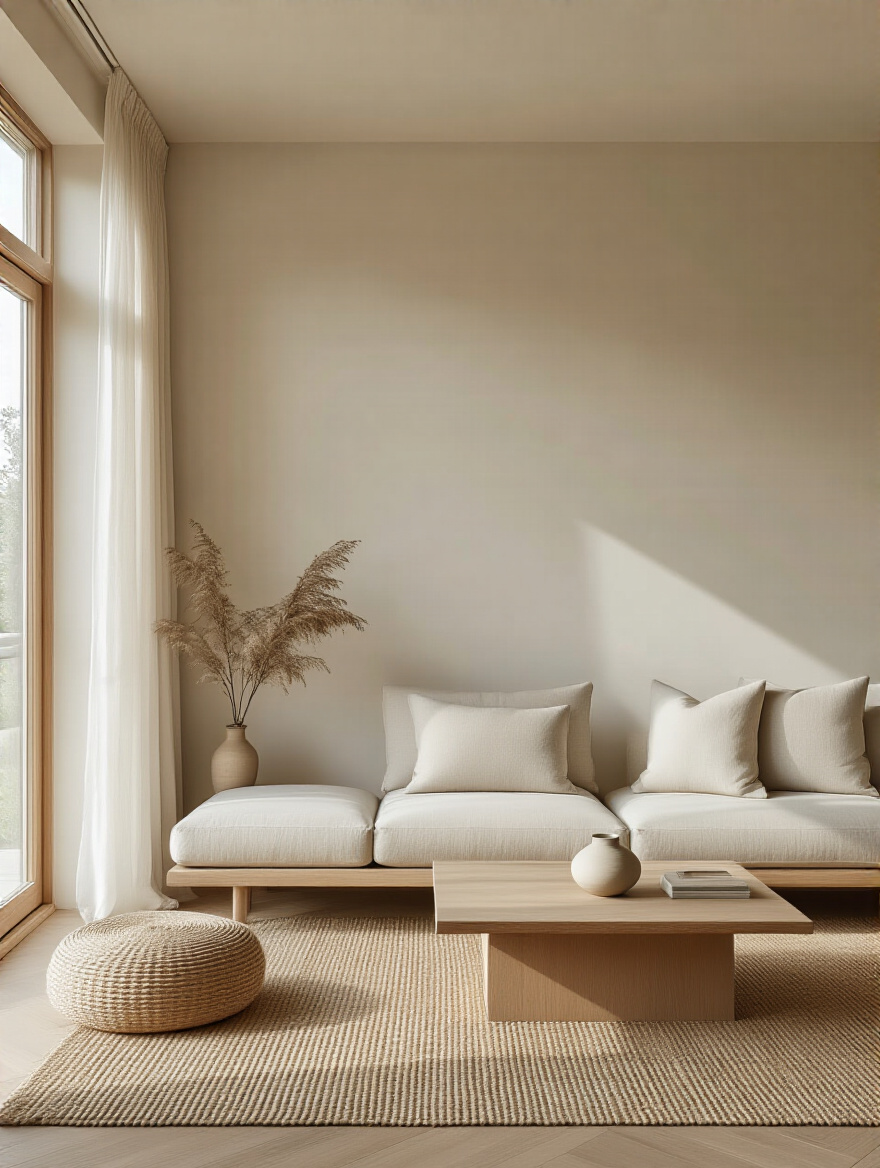
I once had a client, a potter, who wanted a “minimalist” living room but kept buying these tiny, intricate Decorative Objects. Her space felt busy and anxious, the opposite of what she wanted. When we sat down, her ‘why’ was “a gallery-like space to let my mind breathe and recharge.” Suddenly, it was obvious. Those tiny objects weren’t helping her breathe; they were making her mentally gasp for air. Once she had her ‘why’, she knew exactly what had to go.
Now you have a compass. Let’s use it to tackle the first, most intimidating step.
Looking at an entire cluttered room is completely overwhelming. It’s the number one reason people give up. So forget the whole room. I want you to pick one surface. Just one. Your coffee table. The mantelpiece. That one bookshelf that drives you crazy. We’re going for a quick, dramatic win that will give you the hit of dopamine you need to keep going.
This is my go-to shortcut for clients who are frozen with anxiety. Take everything off that one surface. Everything. Now, put back only three things: something you love, something useful, and something alive (like a small plant). Look at it. Feel that? That little pocket of calm is your proof of concept. You just proved to yourself that you can do this. The momentum you get from that one clean surface is more powerful than any 10-point plan.
With that first win under your belt, you need a system to make sure the clutter doesn’t just creep back in.
Here’s the BS everyone believes: that you do a big decluttering weekend and you’re set for life. It never works. Minimalism isn’t a one-time event; it’s a practice, like yoga or learning an instrument. The “One In, One Out” rule is how you practice. It’s simple: for every new thing that comes into your living room—a book, a cushion, a vase—one thing in that same category has to leave.
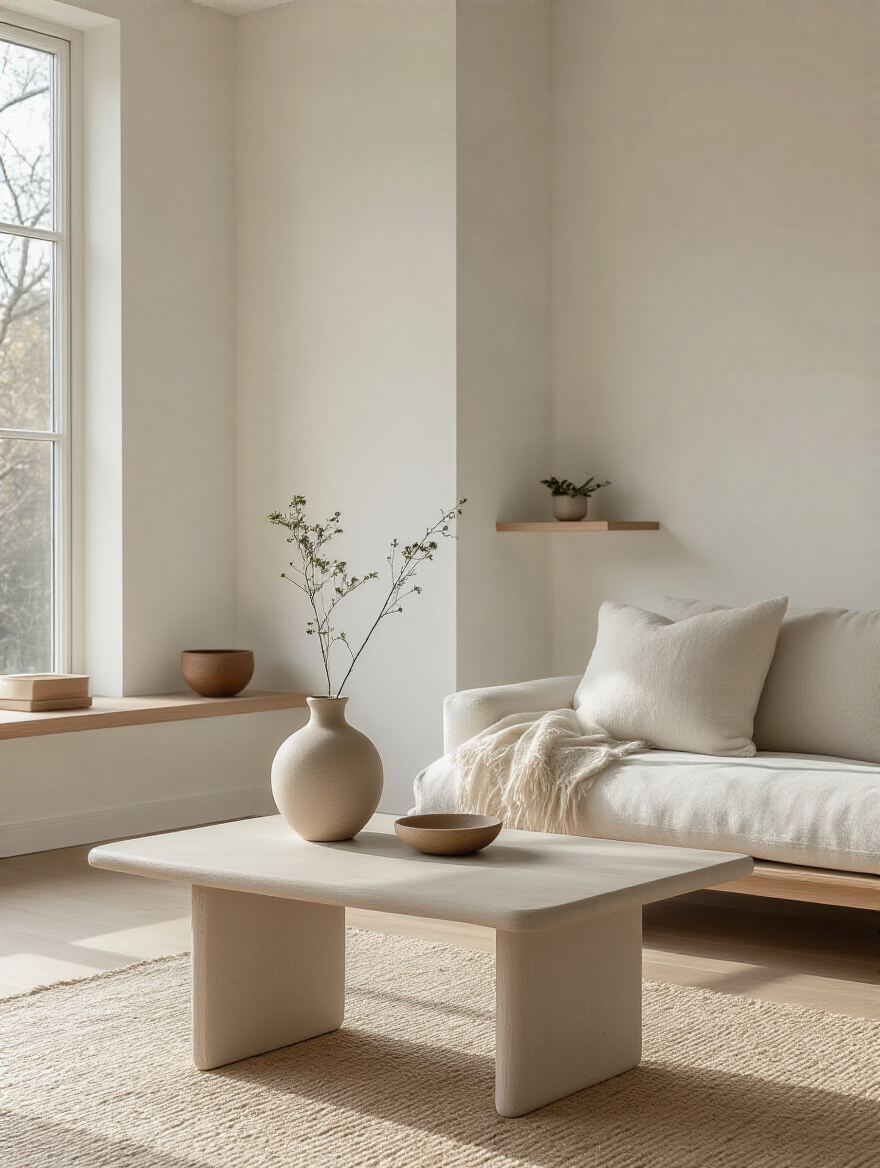
This isn’t about punishment; it’s about conscious consumption. It forces you to pause before you buy that new throw pillow and ask, “Is this truly better than one I already have? Am I willing to let one go for it?” I have a client who keeps a donation bag in her front closet. When a new item comes in, the old one goes directly into the bag. No hesitation. This single habit is the difference between a living room that stays serene and one that slowly reverts to chaos.
Now that we’re managing the flow of stuff, let’s talk about the most important thing you can have: nothing at all.
As a painter, I know that the most powerful parts of a composition are often the empty spaces. The same is true for your room. “Negative space” is just a designer’s term for visual breathing room—the empty floor around a chair, the clear surface of a table, the bare part of a wall. It’s not “wasted” space. It’s active space. It’s what allows your chosen items to actually be seen and appreciated.
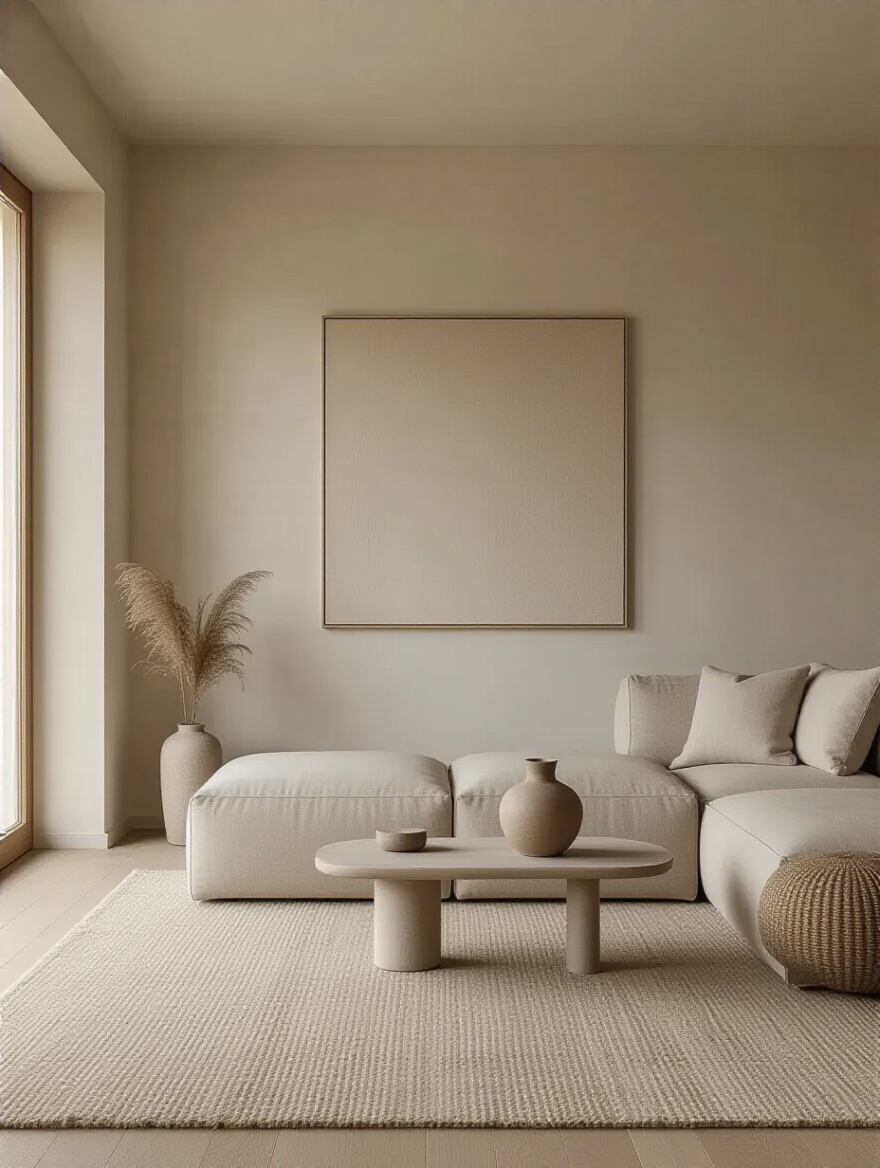
A cluttered room is visually noisy. There are too many things screaming for your attention. Negative space is like hitting the mute button. I wish someone had told me this earlier in my design career. I used to think I had to fill every corner. But the real magic happens when you have the confidence to leave something empty. Your statement pieces will look more important, your room will feel bigger, and your mind will feel calmer.
So, how do you create all this glorious negative space? It starts with a serious sort.
Okay, time to get tactical. The 3-Box Method is the fastest, no-nonsense way to rip the band-aid off. Grab three boxes or bins and label them: Keep, Donate/Sell, and Trash/Recycle. That’s it. Don’t overcomplicate it with a “Maybe” box—that’s just a procrastination station. Pick up one item, and make a decision. Instantly. Does it align with your ‘why’? Does it serve a real function or bring you overwhelming joy? If it’s a “yes,” it goes in Keep. If not, it goes in one of the other two boxes.

The real shortcut here is what you do after. The second you are done with a session—even if it’s just for 15 minutes—the Trash box goes out to the bin, and the Donate box goes directly into the trunk of your car. Do not let it sit by the door for a week. The goal is to get the unwanted energy out of your home as quickly as possible. This creates a vacuum of calm that is incredibly motivating.
This method will also reveal something else: how much redundant stuff you own.
I confess: I once discovered I owned five different tubes of the exact same shade of black acrylic paint, all half-used. We all do this. We have six remotes when we only use two, ten coffee mugs when we only reach for our favorite three, a tangled mess of charging cables when we only need one of each type. Gather up all the items from a single category—all the blankets, all the coasters, all the candles—and put them in one place.
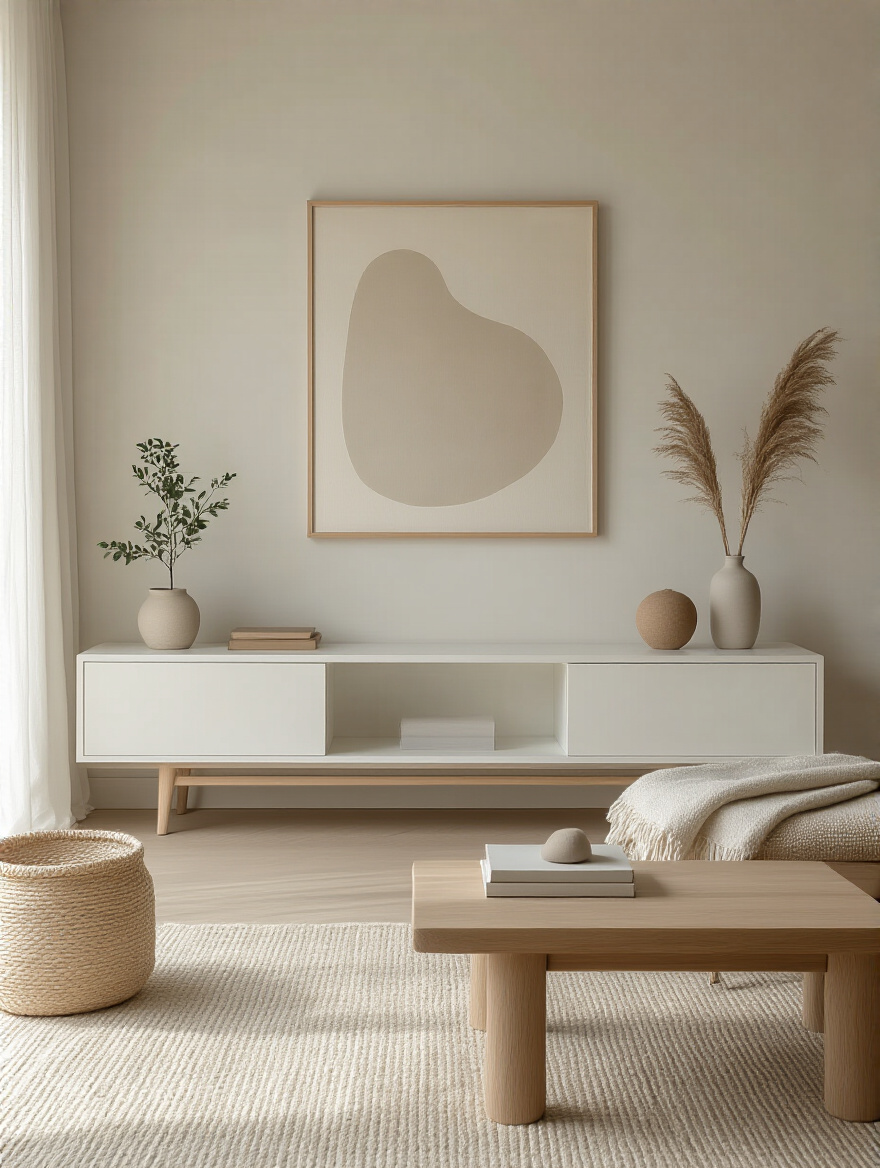
When you see them all together, the absurdity becomes clear. You’ll instantly know which one is the “best.” Keep the best, and get rid of the rest. I had a client who did this with their throw blankets. They had twelve. Twelve. We piled them up, they chose their four absolute favorites (the coziest, the most beautiful), and donated the other eight. Just like that, they freed up an entire storage ottoman and their sofa instantly looked more elegant and intentional.
With the clutter gone, your room is a blank canvas. Now we get to the fun part: arranging the “big rocks.” The furniture you choose and where you place it will define the entire feeling and function of your living room.
When I first started designing, I thought “multi-functional furniture” just meant those clunky, uncomfortable futons from the 90s. But it’s come so far. We’re talking about sleek coffee tables that lift up to become dining tables, beautiful ottomans with massive hidden storage inside, or modular sofas you can rearrange for movie night. In a minimalist space, every single piece needs to earn its keep.
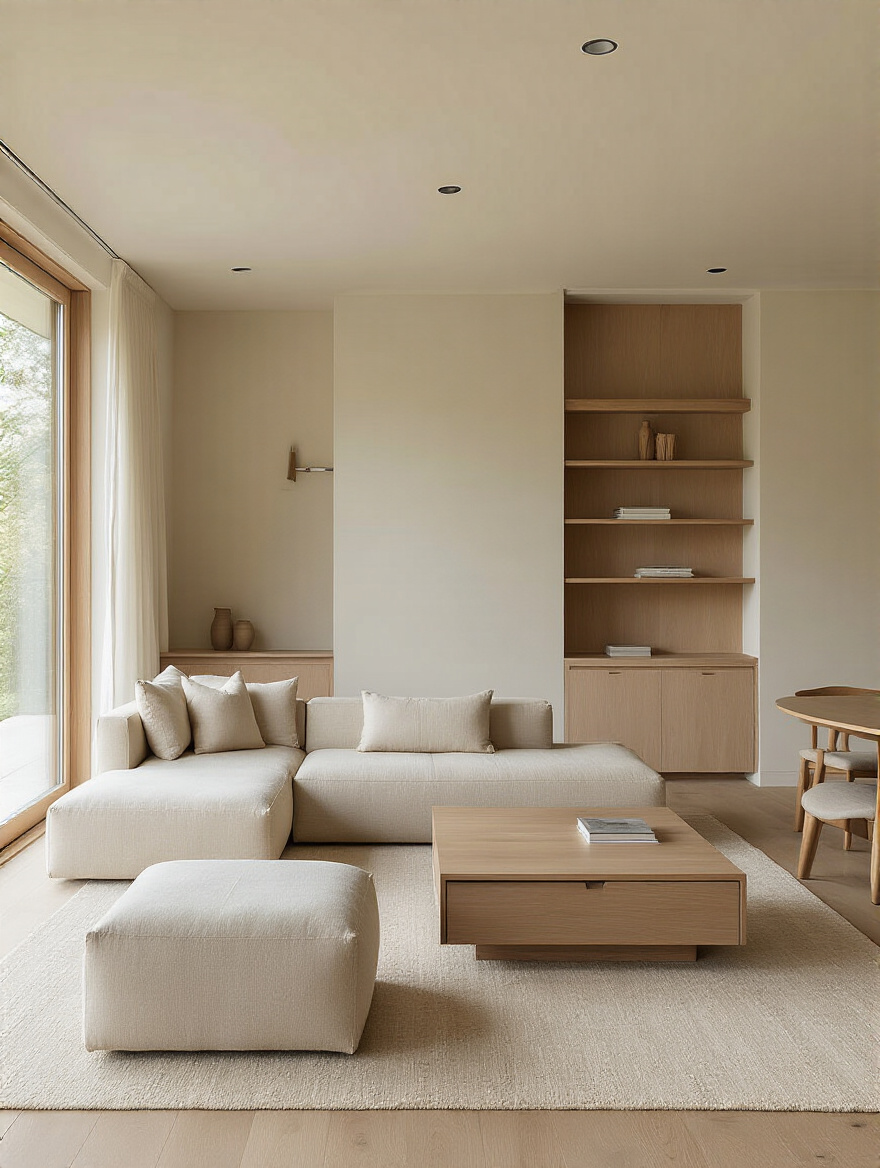
The goal is to have fewer pieces of furniture that do more work. This isn’t just about small spaces; it’s about visual simplicity. Instead of a coffee table, a storage chest, and an extra footstool, you can have one beautiful piece that does all three. This single strategy reduces visual clutter, frees up floor space, and makes your room feel incredibly adaptable and intelligent.
When you’re choosing these hard-working pieces, remember this next point.
Here’s the truth: cheap furniture is visual and energetic clutter. That wobbly particle-board bookshelf or that pilling, fast-fashion sofa creates a low-level hum of anxiety in a room. You can feel the impermanence. Investing in one high-quality, solid piece of furniture instead of three cheap ones is one of the most powerful minimalist moves you can make. It’s the difference between buying professional-grade art supplies and using a kid’s watercolor set. Both make marks, but the experience and the result are worlds apart.
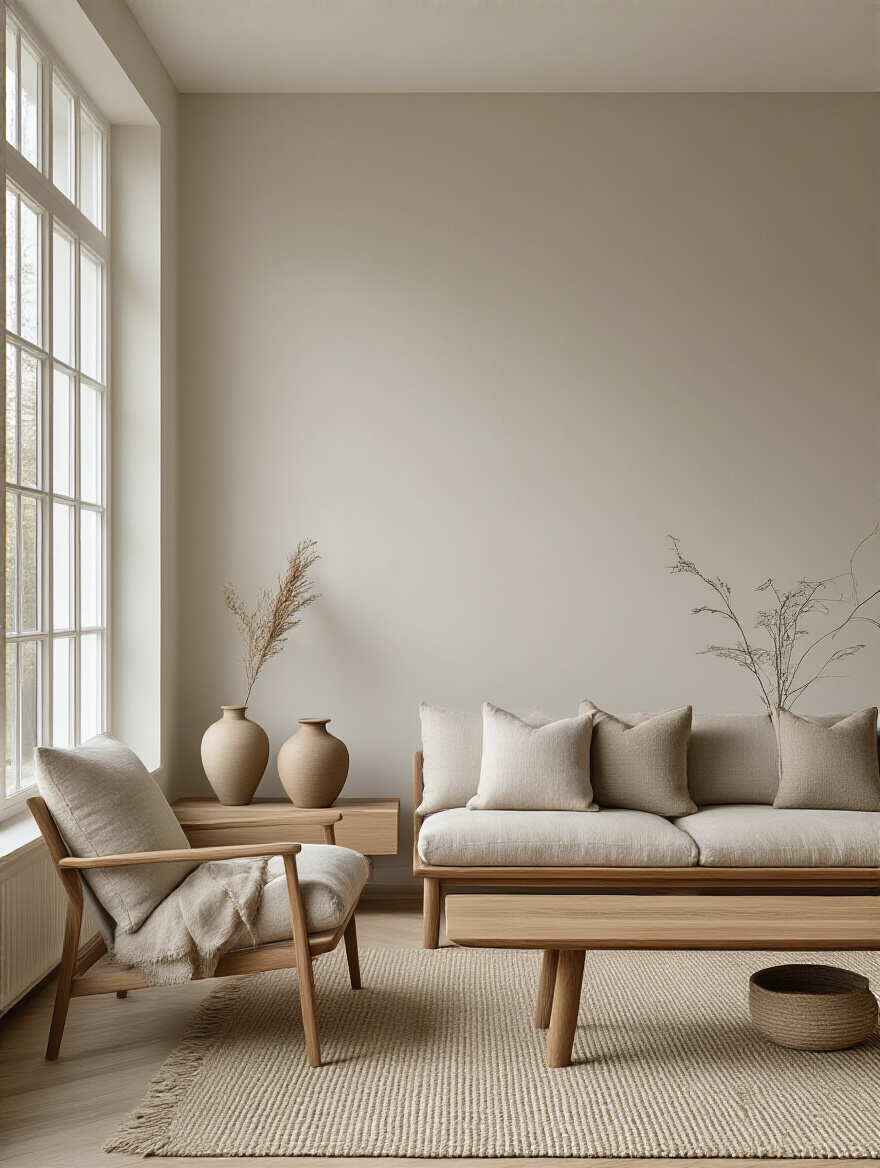
Run your hand over a solid wood table. Feel the weight of a well-made chair. There’s a “thud factor”—a sense of permanence and peace that comes with quality. These pieces become the quiet, reliable anchors of your room. They last longer, saving you money and hassle in the long run, and their timeless design means you won’t get tired of them in two years.
And speaking of timeless design, let’s talk about shapes.
Have you ever noticed how furniture with lots of ornamentation—scrolled arms, tufted backs, intricate carvings—shouts for attention? In a minimalist space, we want the furniture to speak in a calm, confident voice, not scream. This is where clean lines and simple silhouettes come in. Think straight legs, gentle curves, and unadorned surfaces.

This isn’t about being boring; it’s about creating a tranquil foundation. The simplicity of the forms allows other things, like texture, light, and a single piece of stunning art, to take center stage. I tell my clients to think of their big furniture pieces (sofa, console table) as the “canvas.” If the canvas itself is too busy, anything you put on it will just get lost in the noise.
Of course, a room full of simple shapes needs one thing to give it a soul.
Every great story needs a protagonist, and every great room needs a statement piece. In a minimalist setting, this piece is absolutely critical. It’s the anchor that keeps the whole space from floating away into sterility. It’s the one thing you give permission to be bold, to have a huge personality, and to tell a story. It gives the eye a place to land and says, “This is what this room is about.”
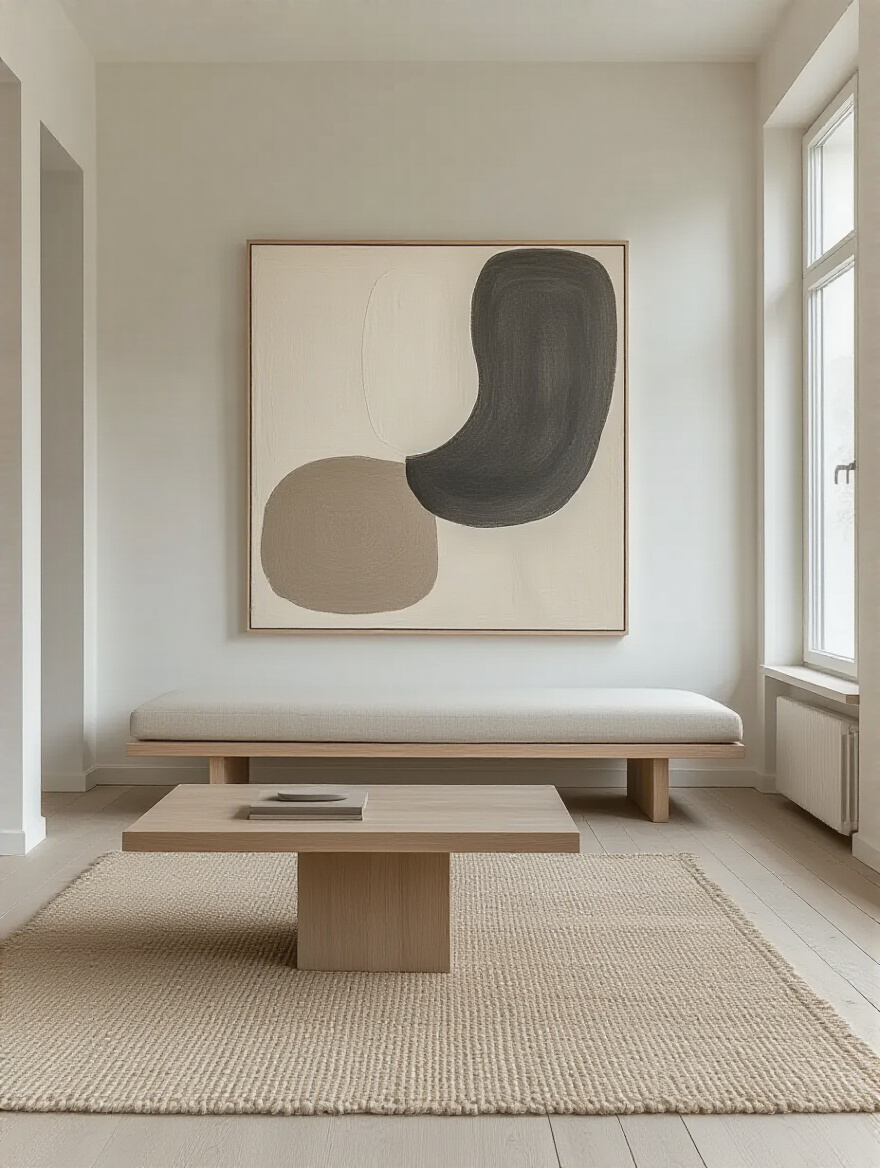
Your statement piece could be a sculptural light fixture that hangs like a piece of art, a vintage armchair with a unique shape, or a massive, vibrant painting. The key is that there is only one. I had a client with a beautiful, serene living room that felt… a little dead. We found a single, stunning, live-edge wood coffee table. It was organic, wild, and powerful. It instantly grounded the entire room and gave it the “wow” factor it was missing, without adding any clutter.
Once you have your protagonist, you need to set the stage for it.
How you move through a space has a massive impact on how you feel in it. A room where you have to constantly weave around furniture feels stressful and cramped, like a badly choreographed dance. Your goal should be to create clear, generous pathways that make walking through the room feel effortless and graceful. This sense of flow is one of the most underrated elements of a serene space.
The designer’s rule of thumb is to have at least 36 inches for a main walkway. Grab a tape measure and check your own paths. You’ll be shocked at how often furniture creeps into the flow. Pushing furniture back against the walls doesn’t always work; sometimes you need to “float” pieces to create a more natural path. This instantly makes a room feel larger, more welcoming, and profoundly calmer.
These clear paths also help you define specific areas for specific tasks.
Even in one big living room, you do different things. You might have a conversation area, a TV-watching zone, and a quiet corner for reading. The mistake people make is letting all these activities bleed into each other. The solution is to use your furniture to create invisible “rooms” within the room. A large area rug is the easiest way to do this. A rug can anchor a sofa and two chairs, instantly defining the “conversation zone.”
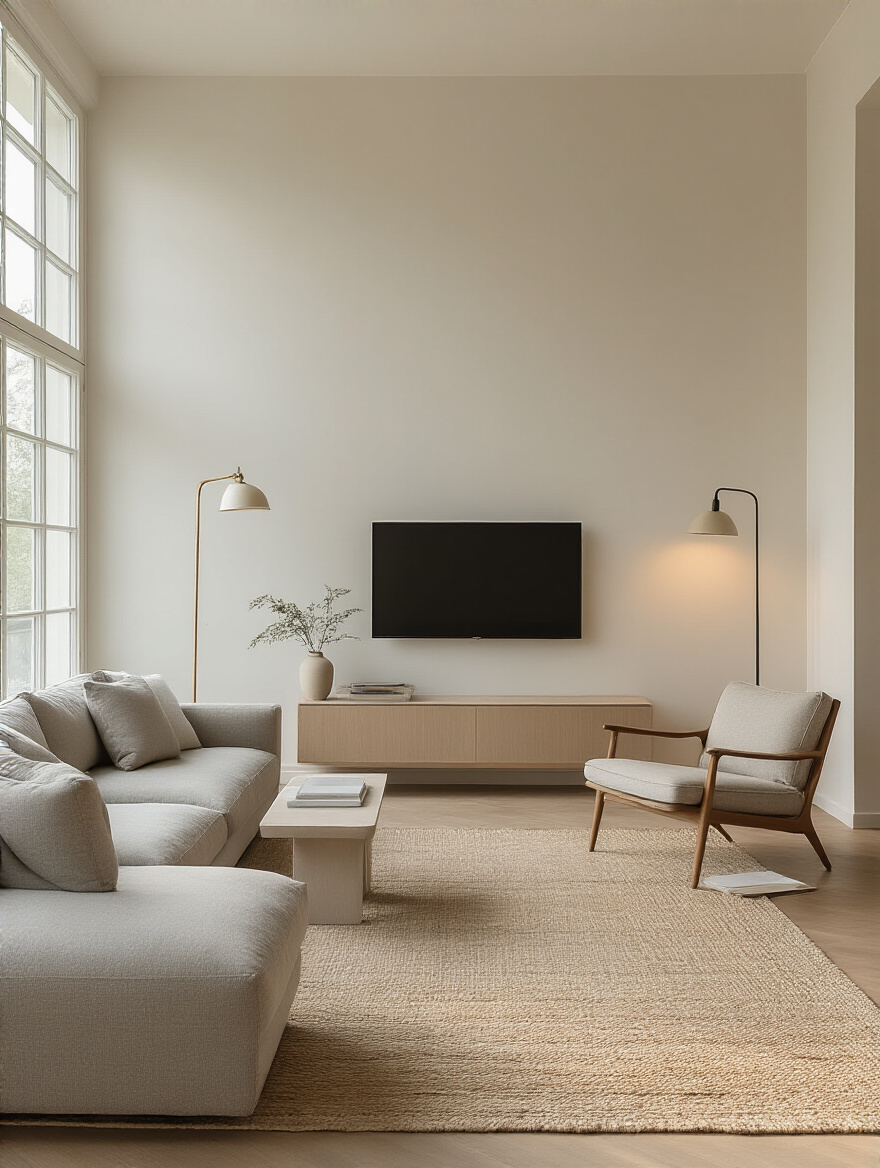
Another trick is to use lighting. A beautiful floor lamp arching over an armchair and a small side table instantly says, “This is the reading nook.” By grouping furniture with purpose, you give every square foot of your room a clear job. This enhances the room’s functionality, but more importantly, it creates a sense of order and calm. The visual chaos disappears when every item clearly belongs to a specific, defined “zone.”
Now that the physical structure of your room is in place, it’s time for the magic. Light, color, and texture are the tools you’ll use to bring your minimalist space to life, transforming it from merely uncluttered to deeply soulful and inviting.
Can we please bust the myth that neutral is boring? It’s not. It’s the sophisticated, essential backdrop for everything else. Think of it as the gallery wall on which you’ll hang your life. Shades of white, cream, beige, and grey are calming to the nervous system. They don’t shout for attention, which gives your mind a break. They also do this brilliant trick where they bounce light around, making any room feel bigger and airier.
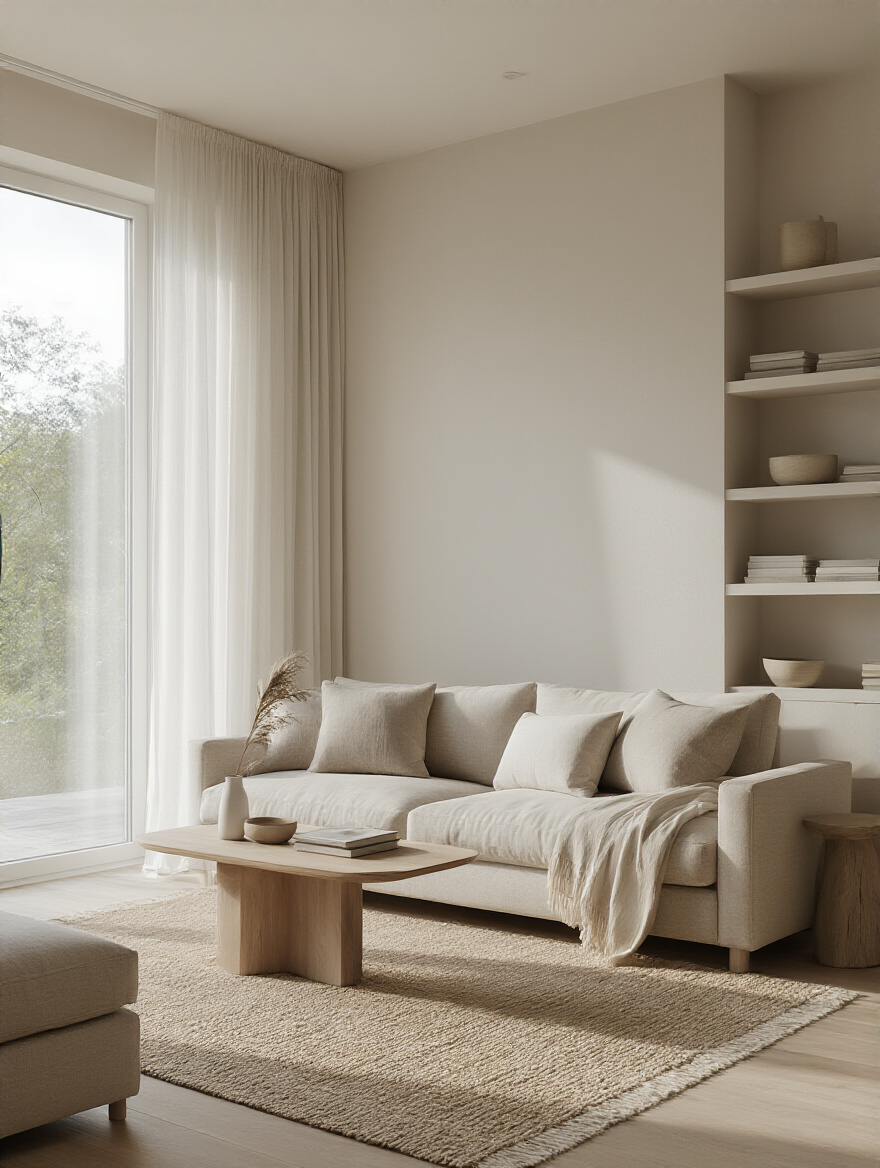
The secret to a beautiful neutral room is to layer different tones and, most importantly, textures. A warm white on the walls, a soft grey sofa, a cream-colored wool rug, and light wood floors—none of these things are “boring.” Together, they create a rich, complex, and incredibly serene tapestry. The neutrality is what allows the form of your furniture and the texture of your fabrics to really sing.
And that brings us to the most important element for adding warmth.
This is my favorite part. A room can be perfectly decluttered and arranged, but without texture, it will feel cold and sterile. Texture is what makes a room feel human and inviting. I’m talking about the nubby weave of a linen pillow, the soft pile of a wool rug, the smooth grain of a wooden table, the cool surface of a ceramic vase. These Natural Elements connect us to the earth and provide the sensory richness that our brains crave.
I encourage my clients to think of texture as a “silent” pattern. You can layer a chunky knit throw, a sheepskin rug, and a leather accent chair—all in the same color family—and create a space that feels incredibly rich and complex without a single busy print. It’s the secret to making a minimalist room feel like a cozy, warm hug.
As you layer textures, you need the right lighting to show them off.
Natural light is your best and cheapest design tool. Period. It’s the ultimate minimalist accessory because it adds beauty, energy, and a sense of spaciousness without adding a single object to your room. Do whatever you can to let more of it in. Ditch the heavy, fussy curtains for simple, sheer blinds or linen drapes that let the light filter through.
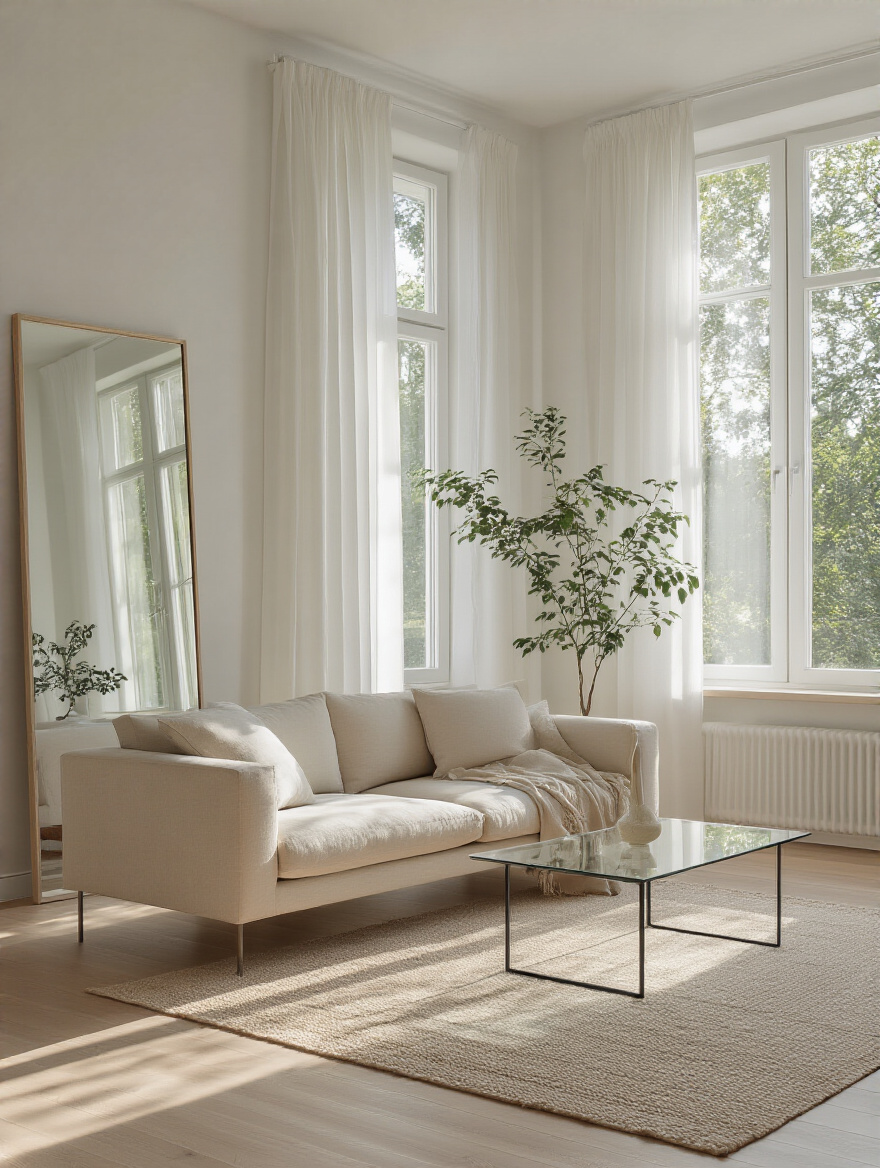
Position your furniture to celebrate the light, not block it. And never, ever underestimate the power of a clean window. You’d be amazed how much light a bit of grime can block. When you flood a room with natural light, all those beautiful textures you added come to life, the clean lines of your furniture are beautifully defined, and the whole space feels more optimistic and alive.
When the sun goes down, you need a smart plan for artificial light.
Here’s a pet peeve of mine: walking into a beautifully designed room that is lit by a single, harsh overhead light. It kills all the mood and creates terrible shadows. A great room needs layers of light, just like a great painting needs layers of color. Think of it in three parts:
Having all three, each on its own switch or dimmer, gives you complete control over the feeling of your room. You can transition from bright and functional for daytime work to warm and intimate for a relaxing evening, all with the flick of a switch. This is what makes a room feel truly dynamic and sophisticated.
Let’s talk about another trick for playing with light.
A well-placed mirror is the oldest trick in the designer’s book for a reason: it works miracles. A mirror can double the visual size of a room and amplify the light you have. But here’s the shortcut everyone misses: the power of a mirror is not in the mirror itself, but in what it reflects.
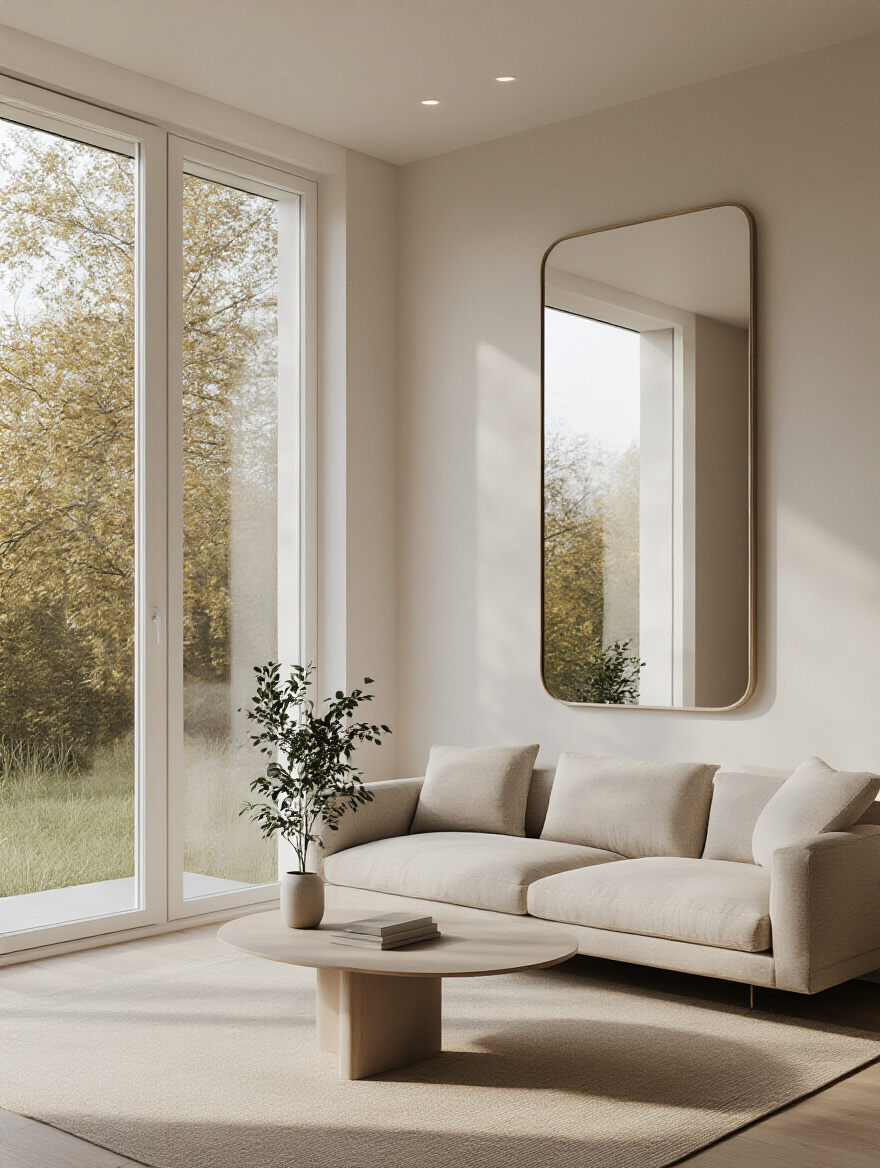
Don’t just hang a mirror on any empty wall. Place it strategically. Hang it opposite a window to bounce natural light all over the room and “bring the outdoors in.” Place a large floor mirror in a dark corner to reflect light back into the space. A mirror reflecting a beautiful piece of art or a striking architectural feature adds depth and interest. A mirror reflecting a cluttered corner, on the other hand, just doubles your problems.
Now let’s add the one thing that truly brings a space to life.
A minimalist room without any life can feel a bit like a museum. Plants are the perfect antidote. They are living sculptures that add organic shape, natural color, and a touch of wildness to an ordered space. They clean the air, of course, but more importantly, they connect your home to the natural world, which has a deeply calming effect on our minds.
The key is to treat them like any other curated object. Choose planters with clean lines and simple materials (terracotta, concrete, ceramic) that complement your decor. Instead of ten tiny, cluttered pots, try one or two larger, statement plants, like a Fiddle Leaf Fig or a Monstera. They have a huge architectural impact and instantly make a room feel fresh and vibrant without adding clutter.
And finally, the soul of the room.
Please, do not use art as “wall filler.” In a minimalist room, art is the heart. It’s the main event. And just like with a statement piece of furniture, the power comes from its singularity. One large, meaningful piece of art has a thousand times more impact than a gallery wall of a dozen small, generic prints. Giving art a generous amount of negative space around it tells your brain, “This is important. Pay attention.”
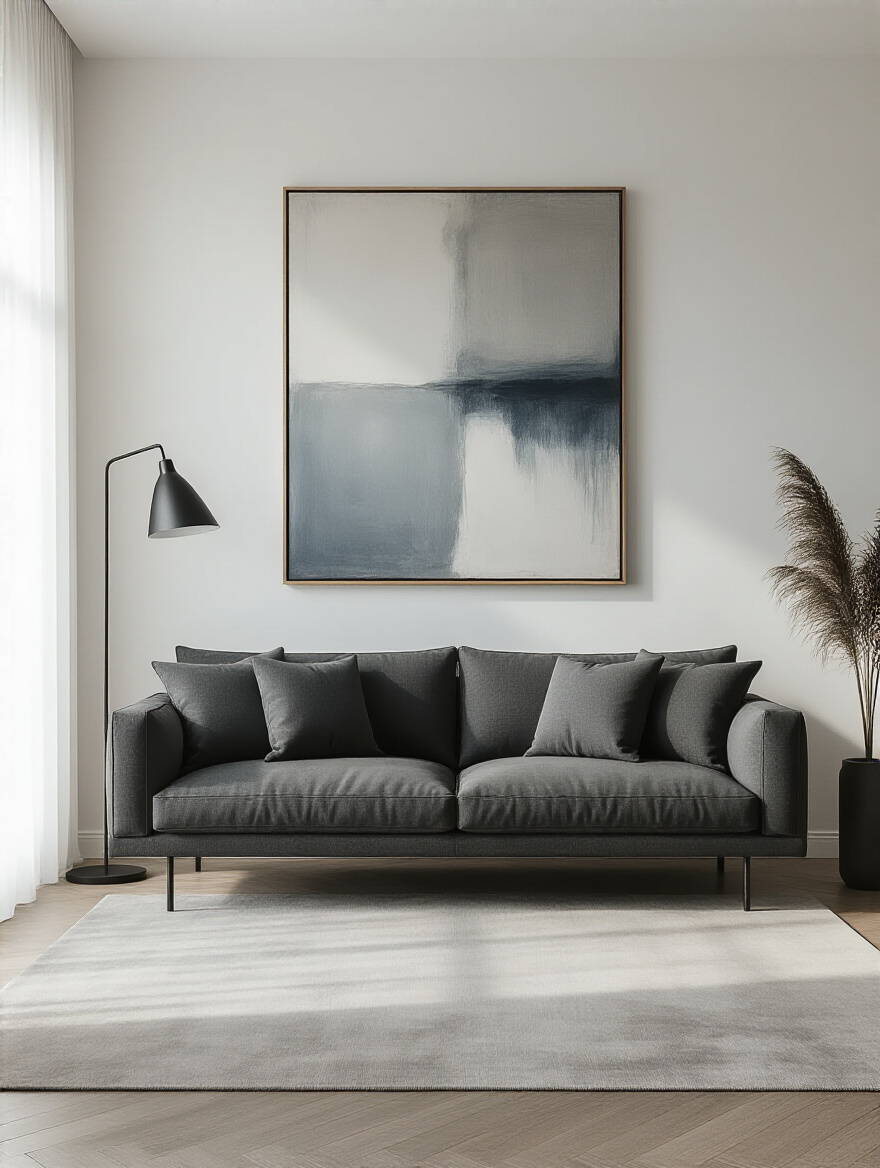
Hang it at the right height—the center of the piece should be at about eye level (roughly 57-60 inches from the floor). This connects it to the human scale of the room. Choose something you genuinely love, something that tells a story or evokes an emotion. That personal connection will radiate out and fill the entire space with character and soul.
Okay, we live in the real world. We have stuff we need to store. The key to maintaining a serene living room is to be incredibly clever about where that stuff lives, and to be just as intentional with the few items we do choose to display.
This is the magic trick behind every effortlessly tidy minimalist room. The mess is still there—it’s just hiding in plain sight. Invest in furniture that does double duty as storage. That beautiful media console with solid doors that hide all the electronics. That chic coffee table with drawers for remotes and coasters. And my absolute favorite: the storage ottoman, a true workhorse that can hide blankets, kids’ toys, or workout gear.

The goal is to have a “home” for every category of stuff that tends to create clutter. When you can sweep all the visual noise into a hidden compartment in under 60 seconds, maintaining a serene space becomes incredibly easy. Custom built-ins that are painted the same color as the wall are the ultimate pro move, as they provide massive storage while virtually disappearing.
But you can’t hide everything, so let’s look up.
Stop thinking about your floor space. Start thinking about your wall space. Floating shelves are a minimalist’s best friend. They provide storage and display space without the heavy, boxy footprint of a traditional bookcase. They create a sense of airiness and draw the eye upward, making the room feel taller.
The key to using them is restraint. Do not pack them full. Remember your negative space! Arrange a few curated items on each shelf—a stack of books, a single vase, a small sculpture—and leave plenty of breathing room. You can also mix in some stylish boxes or baskets on the lower shelves to tuck away less-pretty essentials, keeping the upper shelves for display.
This brings us to what you actually put on those shelves.
We’re back to my favorite mantra. Now that you have a place for everything, be ruthless about what earns a spot out in the open. The surfaces of your room—your mantel, your console, your shelves—are not for storage. They are for beauty and meaning. For each surface, choose just a few items that you absolutely love. The “Rule of Three” is a great shortcut: grouping objects in odd numbers (one, three, or five) is often more visually appealing than even-numbered groupings.
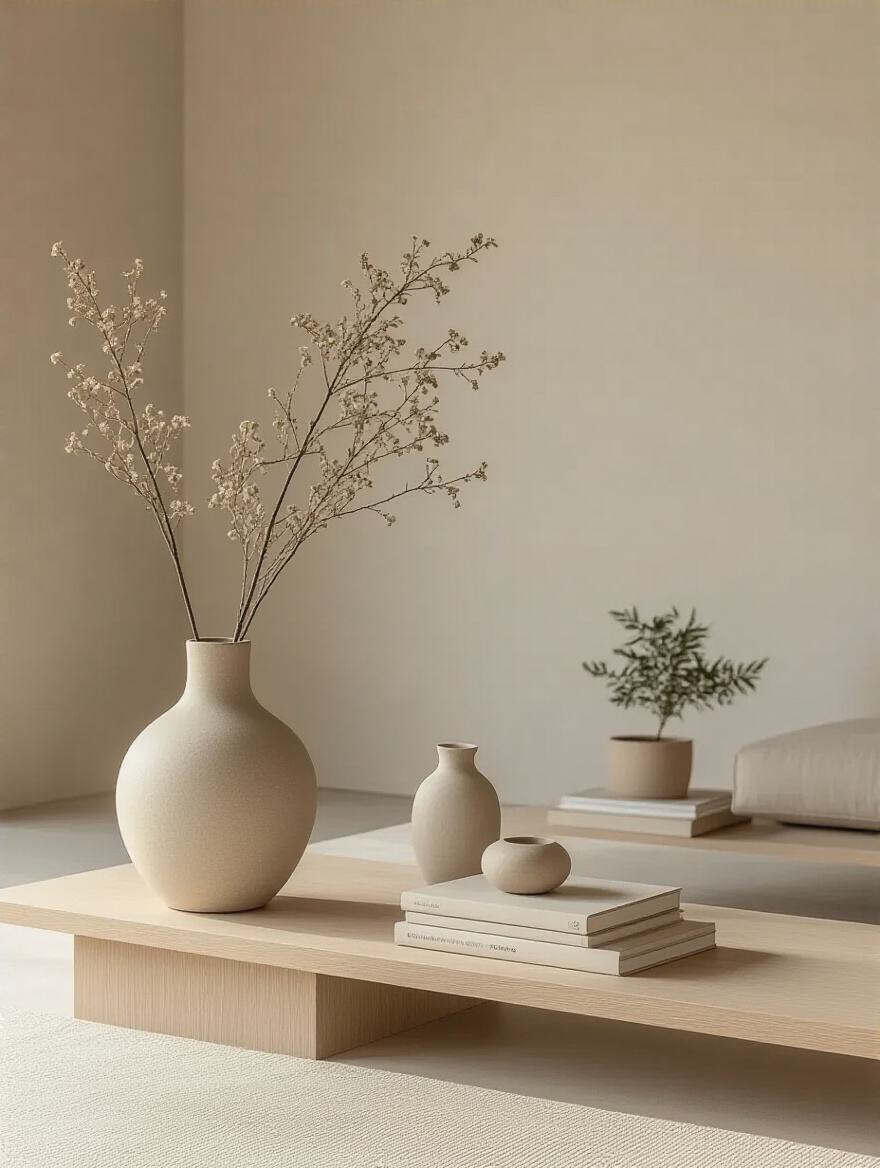
Create small “vignettes”—a stack of two books, a candle, and a small plant, for example. Vary the height and texture of the items. A tiny, curated collection of objects that tells a story is infinitely more powerful and sophisticated than a surface crowded with meaningless knick-knacks.
And for the final touch of comfort…
Throw pillows and blankets are where minimalist rooms often go off the rails. It’s so easy to accumulate a mountain of them. Be intentional. These are the final brushstrokes that add comfort and texture, not clutter. You don’t need more than one or two pillows per sofa section, and one beautiful, high-quality throw is usually plenty.
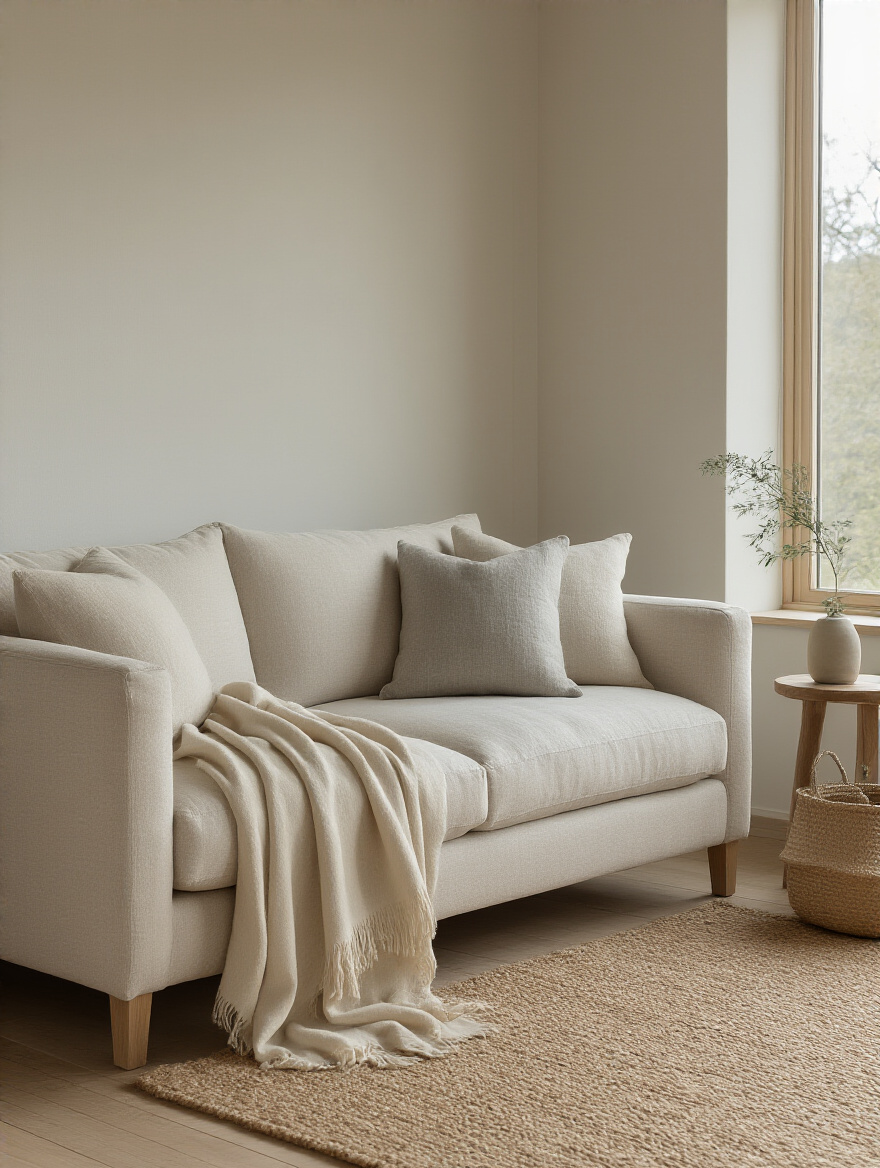
Choose pieces for their texture and material—a rich wool, a soft linen, a cozy boucle. This adds to that sensory warmth we talked about. And think of the blanket as a functional object that also happens to be beautiful. Drape it neatly over the arm of the sofa or fold it in a basket. It should look deliberate, not like an afterthought you just tossed there. This small bit of discipline keeps the whole look clean and intentional.
Creating a serene, minimalist living room isn’t about following a rigid set of rules. It’s about building a new set of habits and a new way of seeing your space. It’s an ongoing conversation with your home. You start with your ‘why’, you clear the static, and you begin to intentionally add back only the things that support that vision—from the hardworking sofa to the single perfect plant.
Don’t try to do all of this in one weekend. Pick one thing from this list. Just one. Clear your coffee table. Buy one great storage basket. Take down all your art and only hang back your absolute favorite piece. See how it feels. Let that little pocket of calm inspire your next move. Your home should be the place that recharges your creative batteries, not drains them. Your serene sanctuary is waiting for you.